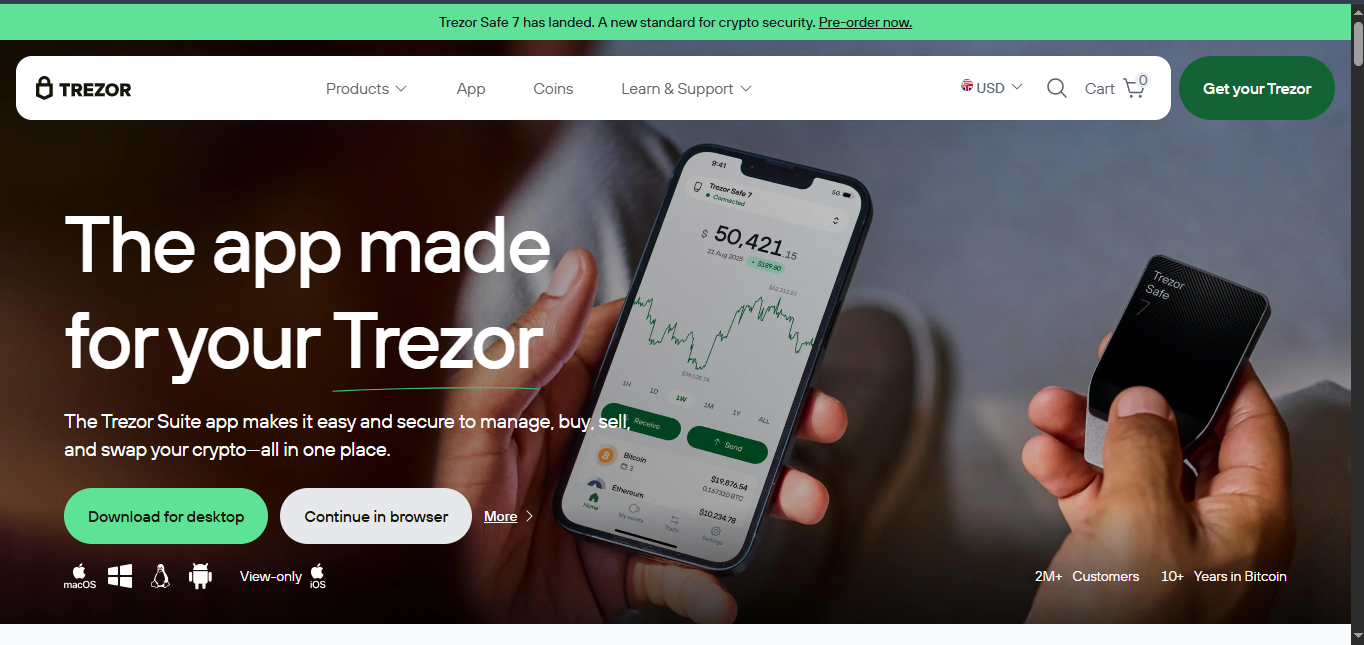
When users unbox a new Trezor wallet, the first recommended step printed on the packaging is to visit Trezor.io/Start. This webpage exists to guarantee that users are interacting with the official setup portal, rather than a phishing site or fraudulent third-party service. Hardware wallet security begins with proper onboarding, so directing users to a verified location is essential.
At its core, the Start page performs three major functions:
Because cryptocurrency transactions are irreversible, these initial steps are not merely administrative—they define how safely your assets will be managed in the long term.
Before you even plug your device in, Trezor encourages you to conduct a quick physical verification. Hardware wallets are designed to resist tampering, but users should still confirm that the device is authentic and unopened.
If anything seems unusual, users should stop immediately and contact official Trezor support before proceeding. Proper verification acts as the first layer of self-custody security.
Once you’re ready to begin, open your browser and manually type Trezor.io/Start.
Avoid clicking on ads or search-result links, as attackers can impersonate legitimate wallet tools.
The Start page will display the model of your device and walk you through the required steps:
Every step is shown with visuals, reducing the learning curve for new users.
Trezor Suite is the official desktop application used to manage your device. It provides:
Installing Suite through Trezor.io/Start ensures you are downloading the correct version and not a fake application designed to steal seed phrases.
When you connect a brand-new Trezor, you may be prompted to install firmware. Firmware is the operating system that runs the hardware wallet, enabling secure generation of private keys.
Suite will guide you step-by-step, and the installation only takes a few minutes.
Once the firmware is installed, you can begin creating your wallet. This is one of the most important parts of the setup process because this is when your recovery seed is generated.
A recovery seed is a sequence of 12, 18, or 24 words generated on your Trezor device.
This seed is the master key to your wallet.
Anyone with these words can access your crypto.
If you lose them, your crypto cannot be recovered.
Your recovery seed should remain offline for the lifetime of your wallet.
After creating your wallet, the system will prompt you to set a PIN code. This is the first defense against unauthorized access to your physical device.
A strong PIN:
If someone steals your Trezor, the PIN helps ensure the thief cannot send funds or extract private keys.
Advanced users can add a passphrase, often described as the “25th word.”
This optional feature turns your main seed into multiple wallets, each secured by a unique passphrase.
The key rule:
If you lose the passphrase, the funds inside that passphrase-protected wallet are permanently unrecoverable.
This feature should be used only after fully understanding its implications.
After initialization, Trezor Suite becomes your central tool for managing digital assets. The interface is designed for clarity:
Shows your total portfolio value, market data, and recent activity.
Allows you to:
Manage:
Suite includes options such as:
Everything is structured to ensure privacy and control remain in the hands of the user.
Once your wallet is set up, you can begin receiving funds. The process involves:
Address verification on the device is crucial, as it prevents malware on a computer from substituting an address controlled by an attacker.
You can share the receiving address with senders once it’s verified.
When sending crypto:
Mandatory device confirmation ensures that you maintain complete control over outgoing transactions.
Owning a hardware wallet is not just about the initial setup but also about maintaining long-term security.
A hardware wallet significantly reduces risk, but safe user behavior is essential.
Trezor is one of the earliest and most trusted hardware wallet manufacturers. Their design principles emphasize:
The company consistently updates its tools to adapt to evolving digital threats.
Trezor.io/Start also connects users to:
If you ever lose access to your device or upgrade to a new model, the recovery seed allows you to easily import your wallet into a new Trezor.
Setting up a Trezor hardware wallet through Trezor.io/Start is the first step toward taking full control of your digital wealth. The process reinforces crucial principles of self-custody—ownership, responsibility, and security. From verifying your device to managing assets in Trezor Suite, every part of the setup is designed to protect your cryptocurrency from theft, hacking, and online vulnerabilities.
By following best practices and learning how your device works, you gain not just a secure wallet but also the confidence to manage digital assets responsibly. With the right knowledge, your Trezor device becomes a powerful tool for navigating the world of decentralized finance while maintaining complete control over your private keys.